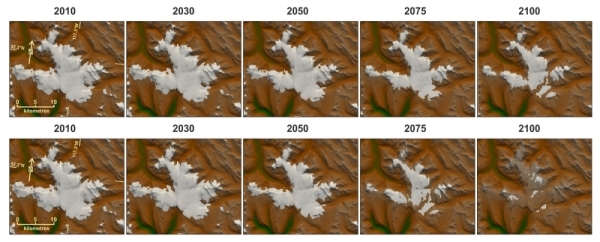Environment File: Bye bye Banff?

Alberta is on track to lose up to 95 per cent of its Rocky Mountain glaciers this century due to climate change, suggests a new report, and a prominent freshwater scientist says that will have a big effect on our water supplies.
Garry Clarke, a retired glaciologist at the University of British Colombia, published a study this week in Nature Geoscience on the future of western Canada’s glaciers under climate change. The study, which has been in the works for about a decade, is unique in that it’s the first to model many individual glaciers across a region at the same time while accounting for the physics of ice flows and local topography.
Clarke’s team modelled the effects of four different climate change scenarios on glacier area and volumes in western Canada over the next century.
The team found that about 70 per cent of the glaciers on the east side of the Rocky Mountains would be gone by 2100 under the best-case scenario for climate change, which is where global greenhouse gas emissions peak by 2020 and fall to about zero by 2100, resulting in 1.5 C of warming.
The world is currently on track for about 4.9 C of warming, which the team found would vaporize about 95 per cent of these glaciers. The Colombia ice field in particular, which draws millions of tourists to Banff and Jasper each year and supplies water to the Saskatchewan river basin, would virtually vanish in this scenario.
Clarke said that the models suggest a complete loss of all glaciers from western Canada a few decades past 2100 in all but the best-case scenario. “The outcome is the same: total loss.”
These glacial losses will be a big problem in water-stressed Alberta, affecting hydropower and cold-water fish habitat, Clarke said. We’ll also see a big aesthetic loss when it comes to our white-capped Rocky Mountains.
The Bow watershed will be the first to feel the impact of this lost ice, said retired Alberta limnologist David Schindler, who has studied the effects of climate change on glaciers and rivers. That watershed, which includes Calgary, gets about 50 per cent of its water in mid-summer from glacier melt.
“Unfortunately, that’s also when human (water) demand on the prairies is the highest,” Schindler said.
The North Saskatchewan would see a lesser impact as it has more tributaries, but will still be squeezed by more evapotranspiration (combined evaporation and plant use), less snowpack and less ice, Schindler said.
“We could easily end up a century from now looking like California.”
Alberta needs to pull out all the stops on water conservation to prepare for this future, Schindler said. That means using grey-water for toilets and lawns and stopping leaks in water mains.
“It is probably time we started the debate: just how many people do we want in water-poor Alberta?”
This model shows that unchecked fossil fuel development is not an option if Alberta wants to have glaciers in its future, Clarke said. However, it also shows that we can keep some of our ice if we make serious efforts to reduce our emissions today.
“There is a clear reward for good behaviour.”
The study is available at nature.com.
Earth Hour powerSt. Albert finished in the middle of the pack during last month’s Earth Hour challenge, but might still get its free home energy audit kits anyway. FortisAlberta released the results of its 2015 Earth Hour Challenge this week. The challenge had 25 Alberta communities compete to see who could reduce their per-capita electricity consumption the most during Earth Hour, which was from 8:30 p.m. to 9:30 p.m. on March 28, with the top three savers getting grants.
Alix, Alta., a village east of Red Deer and west of Buffalo Lake, took first in the challenge by using 39 per cent less electricity during Earth Hour than it did in that same hour on March 21, said FortisAlberta spokesperson Blair Debaar.
The community held a huge outdoor marshmallow and hot-dog roast that got people out of their homes to get that reduction, Debaar said. The village of Alix has been awarded $2,500 to buy LED light-bulbs.
St. Albert came in 14th overall with a 6.9 per cent drop in energy use (or 4,221 kilowatt hours) during Earth Hour, Debaar said – enough to run 3,800 homes for an hour.
That’s an improvement over last year’s 5.1 per cent drop and a new personal best for the city, the Gazette’s records suggest – the previous record was 5.8 set back in 2012.
St. Albert had planned to use a grant from this contest to buy home energy audit kits for the public library, said Mike Mellross, the city’s manager of the environment. He hopes to get at least one kit into the library before the end of the year even without the grant.

Facebook comments